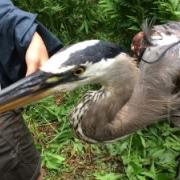Great Blue Heron is Newest Teacher at Easton Schools
On an otherwise quiet Sunday morning before dawn, our headlamps lit the way through cattails and boot-sucking mud as we carried a bucket of baitfish and tubs of traps to a bin set in the shallows of Christina Reservoir in Aroostook County.
Two Years Later, Two More Herons Tagged for Tracking
Two years after five of Maine’s great blue herons were outfitted with high-tech GPS transmitters, IFW once again worked closely with teachers and students from Nokomis Regional High School in Newport, Center Drive School in Orrington, and Haworth Academic Center in Bangor to re-deploy two of the tags on new herons.
Floridians Fetch Feathered Friend, "Snark"
Not all great blue herons migrate, but most of Maine’s breeders choose to spend the winter months in warmer climes at the southern end of the U.S. (Florida) or in another country altogether (Cuba, Bahamas, Haiti). In 2016, we fitted solar-powered GPS transmitters to 5 great blue herons that automatically record GPS locations and transmit data to a website making it extremely convenient for biologists to track the movements of such individuals.
Heron Observation Network's Ninth Year in a Nutshell
Volunteers are Vital From Eagle Lake to Milbridge to Eliot, the Heron Observation Network of Maine completed its ninth year of monitoring great blue heron colonies in an ongoing effort to better understand the status of the population. Great blue herons are widespread throughout Maine; however, a noticeable decline in their coastal nesting population has occurred since the 1980s.
Sedgey's Travels End, But Learning From Nature Continues
For those of you who have followed Sedgey’s travels over the last year and a half, he died on September 25th in North Carolina. Our research partner, John Brzorad from 1000 Herons, was able to locate and collect his remains to be examined by me and a few other biologists and veterinarians to determine the cause of death. The average lifespan of a great blue heron is 15 years.

Meet Our Most Highly Pursued High-Tech Wader: Snark
Have you heard about “Snark,” the first great blue heron in Maine to be outfitted with a GPS transmitter last spring, and the only one to be recaptured a year later? The great blue heron is a Species of Special Concern in Maine due to a decline along the coast.
Meet One of Our High-Tech Waders: Sedgey
Have you heard about “Sedgey,” one of five GPS-tagged great blue herons that IFW and students across Maine are tracking? Sedgey is a male tagged last spring on Sedgeunkedunk Stream in Orrington. He was named by the middle school students at Center Drive School, who helped biologists attract him to a trapping location.
Volunteers Essential for Keeping an Eye on Maine's Herons
Now that winter has finally decided to show up in Maine, I figured I should report on our 2016 field season before the 2017 season is knocking at our door. I guess it takes a blizzard to get me to stay put long enough to enter and analyze the past year’s volunteer monitoring data! The Heron Observation Network’s volunteers have been monitoring great blue heron colonies across Maine for eight years now, and this past year’s effort was just as important as the first year of monitoring.
Tracking Maine's Great Blue Herons - Online!
This spring, MDIFW tagged five adult great blue herons with GPS transmitters as part of an ongoing effort to better understand the state’s great blue heron population. After a significant decline in the number of nesting pairs on Maine’s coastal islands from the 1980s to 2007, MDIFW listed the great blue heron as a Species of Special Concern and began a citizen science adopt-a-colony program called the Heron Observation Network.
HERON Volunteers Fill Crucial Information Gaps
[caption id="attachment_1318" align="aligncenter" width="1024"] Great blue heron nest discovered and photographed by Paul Cyr.[/caption] This past spring while I was focused on completing an extensive aerial survey effort to estimate the statewide breeding population of great b
Keep In Touch!
Enter your email or mobile number to receive the latest news from MDIFW.